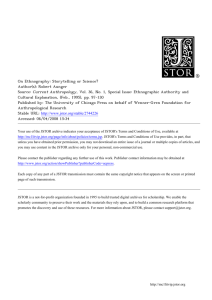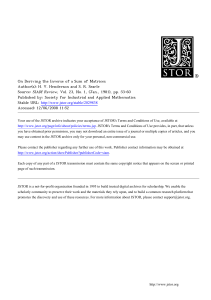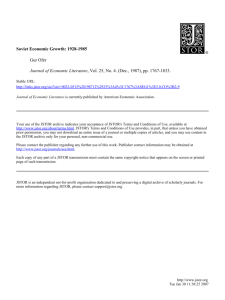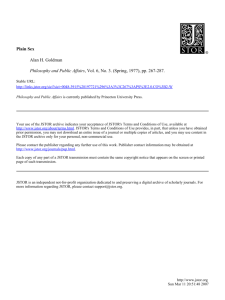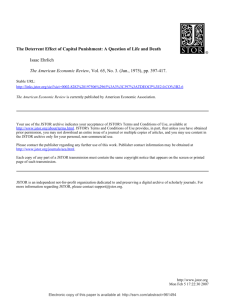Of Rule and Revenue. <contrib contrib
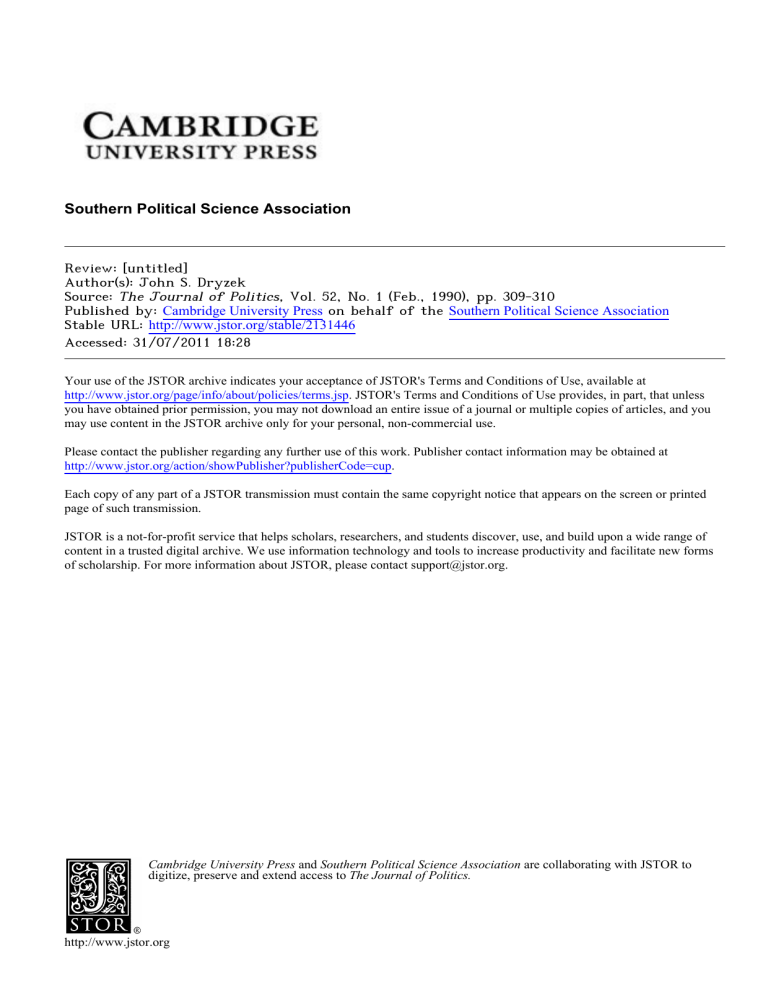
Southern Political Science Association
Review: [untitled]
Author(s): John S. Dryzek
Source: The Journal of Politics, Vol. 52, No. 1 (Feb., 1990), pp. 309-310
Published by:
Cambridge University Press
on behalf of the
Southern Political Science Association
Stable URL: http://www.jstor.org/stable/2131446
.
Accessed: 31/07/2011 18:28
Your use of the JSTOR archive indicates your acceptance of JSTOR's Terms and Conditions of Use, available at .
http://www.jstor.org/page/info/about/policies/terms.jsp
. JSTOR's Terms and Conditions of Use provides, in part, that unless you have obtained prior permission, you may not download an entire issue of a journal or multiple copies of articles, and you may use content in the JSTOR archive only for your personal, non-commercial use.
Please contact the publisher regarding any further use of this work. Publisher contact information may be obtained at .
http://www.jstor.org/action/showPublisher?publisherCode=cup .
.
Each copy of any part of a JSTOR transmission must contain the same copyright notice that appears on the screen or printed page of such transmission.
JSTOR is a not-for-profit service that helps scholars, researchers, and students discover, use, and build upon a wide range of content in a trusted digital archive. We use information technology and tools to increase productivity and facilitate new forms of scholarship. For more information about JSTOR, please contact support@jstor.org.
Cambridge University Press and Southern Political Science Association are collaborating with JSTOR to digitize, preserve and extend access to The Journal of Politics. http://www.jstor.org
Book Reviews 309
Of Rule and Revenue. By Margaret Levi. (Berkeley: University of California
Press, 1988. Pp. 251. $35.00.)
According to Margaret Levi, states and their rulers are predators. Their prey is society, their diet taxation. More precisely, rulers are assumed to maxi- mize state revenue subject to the constraints of the bargaining power of other political actors, the transactions costs involved in tax collection, and their own discount rate. Though built on rational choice assumptions, the theory involves bald statement rather than deduction, and the method, for its part, is historical. The historical illustrations range in time from the third century B.C. to the twentieth century A. D., and in space from Rome to
Australia.
Of Rule and Revenue has ambitions at three levels. First, predation is offered as a candidate for the theory of the state. Second, Levi believes this theory applies to all states at all times. And third, she claims her approach effectively combines microlevel (methodologically individualist) and macro- level (structural) analysis.
The first two claims should turn ultimately on empirical evidence, and the histories presented are moves in that direction. Though careful, informative, and plausible, these illustrations are less than fully conclusive. To begin, the specific hypotheses framed at the beginning of each historical chapter- for example, that "the development of a strong central representative in- stitution, Parliament, in England and the absence of such an institution in
France facilitated quasi-voluntary compliance in England relative to France and, thus, increased the proportion of net revenue to the state" (p. 97)- sometimes look as though they have been influenced by the already known facts of the case. Now, this suspicion may be unwarranted. But a skeptical reader who has assimilated what Sir Karl Popper has to say on this score might prefer a specification of the kind of evidence which would support falsification, followed by a search for it. Instead, what Levi provides is un- remitting, and unavoidably selective, adducement of evidence that bolsters her theory.
The danger here arises because the evidence itself may be preinterpreted in light of the theory. And this in turn may allow substantial elasticity when it comes to matching theory and evidence. For example, William Pitt the
Younger is ascribed a low discount rate on the grounds of his length of tenure in office (p. 132); secure in the knowledge that he was likely to be around a lot longer, he valued future revenues highly in comparison with current ones. Thus Pitt devoted his energy to reorganizing government rather than maximizing immediate revenues. Now, if one wanted to explain a high level of extraction by Pitt, one could point to the threat of war with Napoleonic
France necessitating a high rate of discount on his part. With enough pre- interpretation of evidence, the theory cannot lose. And so it is not clear that
310 Book Reviews
Levi's case studies move beyond the redescription of history in the language of rational choice.
Levi considers the third, metatheoretical claim sufficiently important to merit a 20-page appendix at the end of the book, beyond frequent references in the text proper. A convincing account of how (macro)structural forces de- termine the (micro) properties of agents combined with an explanation in the same terms of how agents determine structures would indeed constitute a major contribution to social science in general. Three schools of thought from which Levi takes pains to distance herself have failed in this task.
Purely structural approaches, favored by the "bringing the state back in" fac- tion, ignore the microlevel altogether. Orthodox Marxists can provide macro to micro explanations (for example, in the theory of alienation), but offer few connections from micro causes to macro effects (and so say little about how alienation leads to and constructs revolution). Public choice successfully develops micro explanations of macro phenomena, but its individuals (and so its explanations) are ahistorical, antiseptic, and insensitive to structural forces.
Levi endorses and adopts public choice assumptions about individuals.
But her individuals have a context: they are "central actors on a historical stage replete with already existing structures and institutions" (p. 203), which constrain their actions. The macro effects these individuals generate (for ex- ample, tax systems) are a function of their interactions, which may be ana- lyzed in the rational choice terms of bargaining, transaction costs, and collec- tive goods.
Here, it would seem, is a resolution of the micro-macro (or agent-struc- ture) problem. But the resolution, though interesting, is not fully convinc- ing, for ultimately the macro outcome is fully determined by the ruler's choice-however constrained that choice may be by the bargaining power of other actors, transactions costs, and so forth. Thus the ruler's contribution to the micro-to-macro explanatory path is crucial. Two related problems sur- face here. First, Levi treats "ruler" as singular. The possibility that multiple rulers of a state might compete with one another for shares of revenue, rather than maximizing total revenue, is excluded, and along with it the pos- sibility that total revenue is a public good for these rulers, liable to collective action problems in its generation. Second, Levi ultimately equates the ruler with the state (L'Etat c'est moi). Thus a large part of Levi's resolution of the micro-macro problem turns out to resemble the "great man" theory of his- tory, which evades the problem by equating the macro with the micro, rather than explaining the macro by the micro.
Irrespective of any shortcomings along these lines, Levi has developed an interesting and plausible perspective on the history of revenue generation.
John S. Dryzek, University of Oregon

